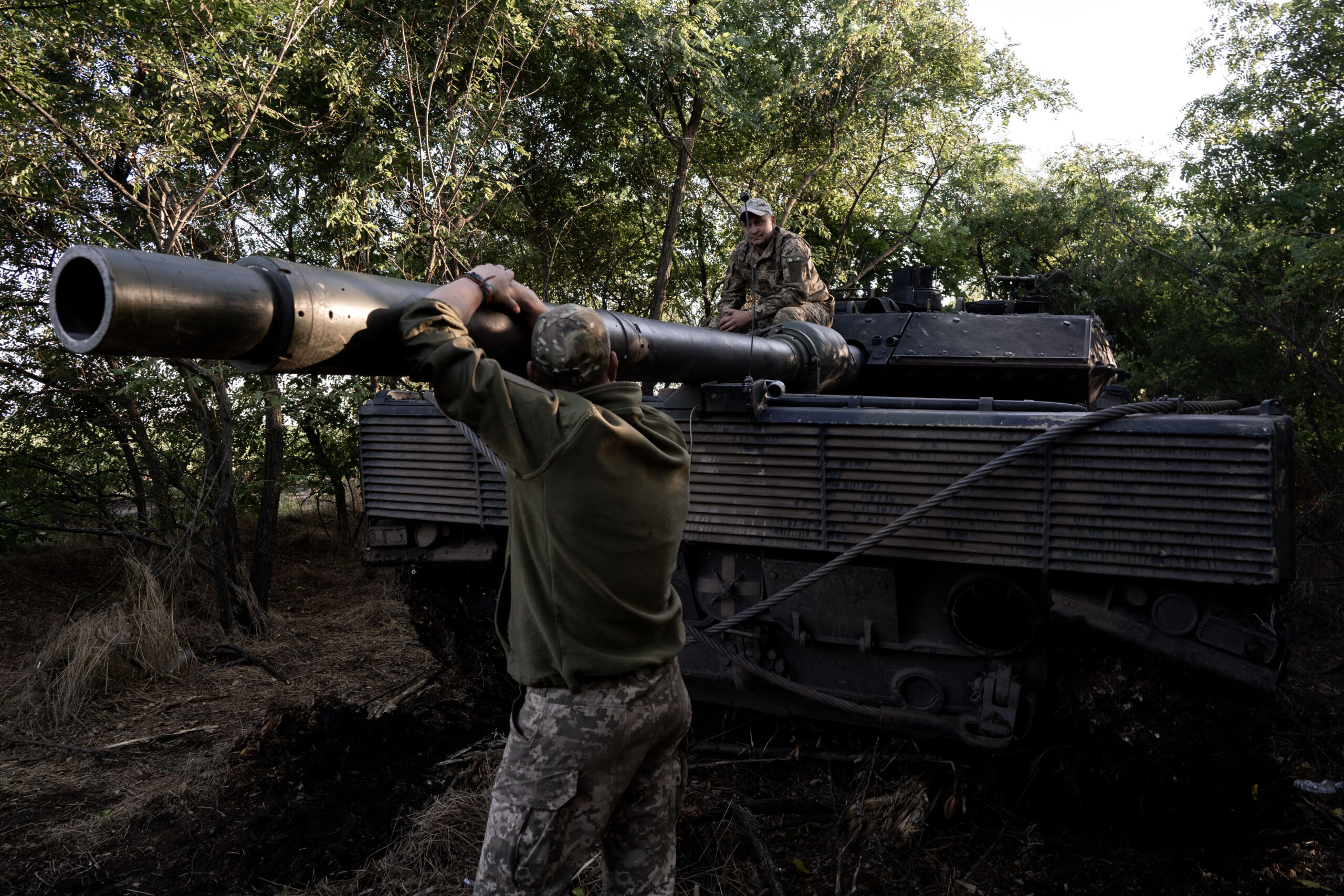A first batch of German-made Leopard 2 main battle tanks used by Ukraine in its fight against Russia’s invasion have been overhauled in Poland and returned to their units. The work was undertaken at a specialized maintenance and repair hub that was set up in Poland, which had only officially opened in April, and which was first confirmed as having received its first Leopard 2s in July.
In a tweet today, the state-owned Polska Grupa Zbrojeniowa, PGZ, or Polish Armaments Group, announced that “The first Leopard tanks rapidly refurbished at Bumar-Łabędy have been received by the Ukrainian side. Work continues on the next vehicles.” A division of PGZ, Bumar-Łabędy focuses on manufacturing, repairing, and overhauling armored vehicles.
Exactly how many tanks were overhauled and returned to Ukraine in this first batch is unclear, although, by any margin, the work appears to have been completed fairly rapidly. We don’t have a precise date as to when the first batch of Leopard 2s arrived at Bumar-Łabędy. However, the Polish Minister of Defense tweeted back on July 22 that the first two had arrived at the plant from Ukraine, so we know they were there by that date.
Ahead of that, PGZ had already been providing similar support to Ukraine, albeit in-country, via its PGZ Service Orel subsidiary, which has, for more than a year now, been “servicing heavy equipment [In Ukraine] close to the front line.” That work has included supporting Leopard 2s as well as Polish-made Krab self-propelled howitzers.
Establishing a specific facility for overhauling Leopard 2s in Poland was by no means straightforward, however.
The center was originally planned to open in late May. But even with “several” Ukrainian Leopard 2s already having arrived at Bumar-Łabędy, as of mid-July there were apparently ongoing disputes between Poland and Germany, reportedly due to disagreements over costs. Clearly, however, those issues were resolved soon after, and the facility is now processing tanks and returning them to Ukraine.
What is also unclear, at this point, is what kind of condition the Leopard 2s were in when they were sent to Poland. With the first batch of Leopard 2s, also provided by Poland, having arrived in Ukraine in late February, the examples in question may very well have seen combat over a period of around five months.

In August, Ukraine claimed that “at least 10” battle-damaged Leopard 2s were being repaired, although it’s not known whether some or all of these were sent to Poland or if the required repair work was carried out in Ukraine.
There have been some high-profile combat incidents involving Ukrainian Leopard 2s already, including the example abandoned, alongside four M2 Bradley infantry fighting vehicles, in an engagement with Russian forces near Mala Tokmachka in Zaporizhzhia Oblast in June. You can read our analysis of that incident here.
According to Oryx, the open-source Dutch intelligence defence analysis website, at least six Leopard 2s have been documented as destroyed in Ukrainian service, and another six damaged, with five having been damaged and then abandoned. The actual numbers are likely higher as Oryx only counts visually confirmed losses. Russian claims of Leopard 2s having been knocked out by their forces have not always been genuine, on the other hand.
Even if the Ukrainian tanks recently processed in Poland were not damaged, the general wear and tear of operations would have meant they were certainly in need of depot maintenance, at the very least. Since these are notably advanced tanks, at least compared to the bulk of Ukrainian armor, they require considerably more and extensive overhauls, even during regular training operations, let alone on the battlefield.
With the Ukrainian counteroffensive well underway, with extensive use of armor, including the more advanced Western-supplied tanks and other armored fighting vehicles, the need for battle damage repairs and general overhauls is greater than ever.
Among Ukraine’s modern Western-made tanks, the Leopard 2 is numerically the most important. The first to arrive in Ukraine were supplied by Poland, which provided 14 examples. Others have been sent by Canada (eight), Norway (eight), Germany (18), Portugal (three), and Spain (10). Another 14 have been pledged by Denmark and the Netherlands, in a joint endeavor. All together, these tanks are a combination of Leopard 2A4 and more modern 2A6 variants. Sweden, meanwhile, has provided Ukraine with 10 examples of the Stridsvagn 122, which is derived from the Leopard 2A5.
It should be recalled, too, that the process of getting clearance from Berlin to provide export licenses for the transfer of Leopard 2s to Ukraine was a long-drawn-out one. Only after months of negotiations and pressure on Germany was the logjam broken in January. At the same time, the U.S. government announced that it would deliver M1 Abrams main battle tanks to Ukraine, with the first of these having arrived there around a week ago. Challenger tanks are also in use in small numbers, as well.
With the possibility of more Leopard 2s being delivered to Ukraine in the future, the Polish maintenance and repair hub is likely to be kept busy. Poland’s own Leopard 2 fleet may also start to use the same facility. As far as Ukraine is concerned, Polish capabilities in this field also extend to the Soviet-era T-64 tank, which also has a maintenance and repair center in Poland, with plans to offer the same for the T-72 and PT-91, as well.
More generally, the prospects for tank maintenance, repair, and overhaul in Europe appear generally good. With the war in Ukraine raging, and a return to prominence for armored warfare, some of the tank fleets in the region are starting to expand again, after a long post-Cold War downturn. With its work in support of Ukraine, Poland looks well placed to capitalize on these developments in the future.
Contact the author: thomas@thedrive.com
